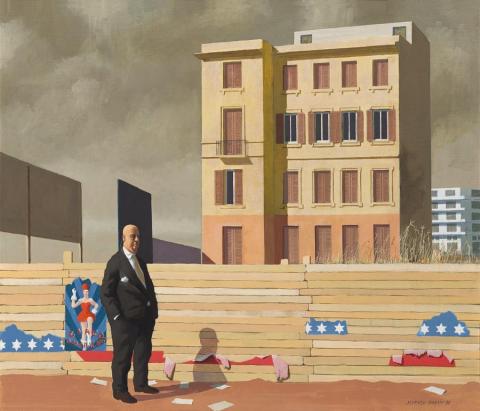ON THE CASSIA, 1965
JEFFREY SMART
oil on canvas
60.0 x 70.0 cm
signed and dated lower right: Jeffrey Smart '65
Macquarie Galleries, Sydney
Institutional collection, Sydney
Jeffrey Smart, Galleria 88, Rome, 8-23 April 1965, cat. 13
Jeffrey Smart, Macquarie Galleries, Sydney, 29 September - 11 October 1965, cat. 9
Art and Australia, September 1965 (illus. inside back cover)
Looby, K., 'The absurd beauty of reality', Hemisphere, vol. 16, no. 11, November 1972, p. 18 (illus.)
Quartermaine, P., Jeffrey Smart, Gryphon Books, Pty Ltd, Melbourne, 1983, pp. 28-29, cat. 452 (illus.)
Allen, C., Jeffrey Smart: Unpublished Paintings, 1940-2007, Australian Galleries, Melbourne, 2008, pp. 37-38, 135 (illus.)
Allowing for Jeffrey Smart's reference to figures being introduced to give scale within his pictures, they often played roles of more fascinating interest. This is certainly so for On the Cassia, 1965 in which the possibilities for the bald headed man range from the artist himself, Alfred Hitchcock-like appearing in his own movies, to someone more sinister, commented on by Christopher Allen in his 2008 book. Of these men in suits, Allen says, 'Usually bald and often wearing dark glasses, they are cast as bureaucrats, property developers, possibly secret policemen or criminals in works such as On the Cassia (1965), Outside the Ministry (1970) or The developer (1982-83).1 Allen found something quite unsettling in Observer II (1983-84), the feeling of being looked at heightened by the 'one eye uncannily magnified'. I find it even more so in On the Cassia where the central figure's interest is the viewer, observed with a suspicion only partly disguised by fictitious nonchalance. Here Smart provides a favourite touch for his agent of secret service - the observer as a dark accent rising upwards from the suit through the screen behind. As Smart once said, 'The fat man in the dark suit, in various guises is in many of my paintings, because a strong vertical black rectangle with a bald head is a lovely shape ...'2 Smart added, 'You have to be very careful because as soon as you put a figure in a painting the viewer's eye goes straight to it, like a magnet.' That is, of course, exactly what Smart wanted. Typically, all is unnervingly still, wrapped in an atmosphere of dereliction. Boarded up, tall grasses grow where life should be; shuttered windows speak of abandonment. With a hearing device in ear, the watcher's back has turned on the imaged marching girl, with the detritus of the Stars and Stripes scattered across the hoarding. The abruptly cast shadow is angled to suggest sudden change of direction, as the watcher turns from what is done to look at us outside the picture's field.
Painted soon after Smart moved to Italy to live, the reference to Cassia in the title may refer to the ancient Roman road of Via Cassia as in 'all roads lead to Rome'. The torn poster 'Circo Americano', however, has a more pointed and poignant reference. The opening day for Circo Americano in Turin was postponed for it was Friday, 22 November 1963, the day of John F. Kennedy's assassination. Boarded up with some windows open, does the closed building recall the Book Depository in Dallas?
For thematic context and aesthetic quality, On the Cassia comes between The Cahill Expressway, 1962 (with a bald headed figure), and The Listeners, 1965.3 Listening devices began to break through many a Smart horizon, soon morphing from seemingly visual absurdities into metaphors of telling significance. Reviewing the 1965 Sydney exhibition in which our painting was shown, James Gleeson wrote, 'He paints a world of threatened serenity.'4
1. Allen, C., Jeffrey Smart: Unpublished Paintings, 1940-2007, Australian Galleries, Melbourne, 2008, p. 38
2. Jeffrey Smart quoted ibid., p. 35
3. In the collections of the National Gallery of Victoria and the Art Gallery of Ballarat respectively
4. Gleeson, J., 'Jeffrey Smart's - still- lifes', Sun-Herald, 30 October 1965, p. 76
DAVID THOMAS
